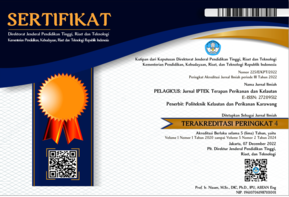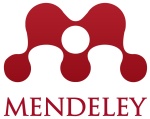Using Seawater Reverse Osmosis (SWRO) Technology in Seawater Desalination Processes
Abstract
Keywords
Full Text:
PDFReferences
Alimah, S (2006) ‘Fenomena kerak dalam desalinasi dengan multi stage flash distillation (MSF)’. J. Pengembangan Energi Nuklir. 8 (1), 46-54.
Charcosset, C. A (2009) ‘Review of membrane processes and renewable energies for desalination’ Desalination. 245 (1-3): 214–231.
Fritzmann, C., Löwenberg, J., Wintgens, T., & Melin, T (2007) ‘State-of-the-art of Reverse Osmosis Desalination’ Desalination. 216 (1-3): 1–76.
Into, M., Jonsson, A. S., & Lengden, G (2004)’ Reuse of Industrial Waswater Following Treatment With Reverse Osmosis’ Membrane science. 24 (2), 21-25.
Khawaji, A. D., Ibrahim, K. K., & Jong, M.W (2008) ‘Advances in seawater desalination technologies’ Desalination. 221 (1-3) : 47-69.
Kristanto, V. H. (2018) ‘Metodologi Penelitian Pedoman Penulisan Karya Tulis Ilmiah (KTI)’ Yogyakarta: CV Budi Utama.
Lautetu, L.M., Kumurur, V. A., & Warouw, F (2019) ‘Karakteristik Permukiman Masyarakat Pada Kawasan Pesisir Kecamatan Bunaken’ J. Spasial. 6(1): 126-136.
Peraturan Menteri Kesehatan No. 32 (2017)
‘Standar Baku Mutu Kesehatan Lingkungan dan Persyaratan Kesehatan Air Untuk Keperluan Higiene Sanitasi, Kolam Renang, Solus Per Aqua, dan Pemandian Umum’ Kementerian Kesehatan.
Peraturan Menteri Kesehatan No. 492 (2010) ‘Tentang Persyaratan Kualitas Air Minum’ Kementerian Kesehatan.
Redjeki, S (2011) ‘Proses Desalinasi dengan Membran. Direktorat Penelitian Dan Pengabdian Kepada Masyarakat (Dp2m)’ Direktorat Jenderal Pendidikan Tinggi Departemen Pendidikan Nasional.
Robiatun (2003) ‘Membran Reverse Osmosa dalam Proses Desalinasi Air Laut’ Buletin penelitian. 25 (3), 38-46.
Semiawan, C.R (2010) ‘Metode Penelitian Kualitatif Jenis, Karakteristik dan Keunggulannya’ Jakarta: Grasindo.
Sugiyono (2009) ‘Metode Penelitian Kuantitatif, Kualitatif dan R&D’ Bandung : Alfabeta.
DOI: http://dx.doi.org/10.15578/plgc.v3i3.11302
Refbacks
- There are currently no refbacks.

This work is licensed under a Creative Commons Attribution-ShareAlike 4.0 International License.
E-ISSN: 2720-9512
ISSN: 2715-9620












